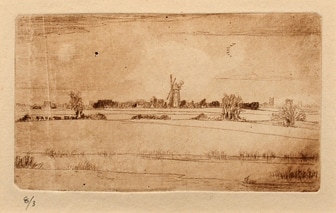|
The reputation of Karl Salsbury Wood (1888-1958) largely rests upon a remarkable series of paintings he produced between the late 1920s and his death in 1958. For almost thirty years Wood cycled around Britain in an attempt to visually record every existing windmill in the country. Wood’s plan was to publish a book titled The Twilight of the Mills containing his illustrations and written notes. In addition to being a talented (and clearly driven) painter, Wood was also a printmaker, as the small collection of etchings on our site illustrates (the full selection can be seen here). The subjects of the etchings reflect Wood’s interest in architecture and architectural details. Structures – castles, churches, inns and the ubiquitous windmills – are predominantly the focal point; the edges of the buildings straining up against the edges of the etching plate. A tree or two might act as the frame for a country church but it was unusual for Wood to record the bigger picture – the landscape the buildings exist within. The prints provide a useful insight into the way in which etchings are created. The etching process, though time-consuming, is relatively straightforward. A metal plate is coated in a layer of acid resistant wax, a design is then drawn on to the wax through to the metal plate and the plate is then immersed in acid. This bites away at the metal elements exposed by the artist’s design; the longer the plate is immersed the deeper the lines will be etched and the darker they will print. The etched image is constructed in stages (known as states), the various elements of the picture being worked on systematically until the finished image is arrived at. Windmill with Pigs (above) is clearly at a very early, rudimentary stage – just the outlines of the windmill and the pigs have been bitten. This print is numbered 1/1 which presumably means this is the first impression Wood took from the first state of the print. Here, Wood continues to develop a design in a third impression. As with Windmill with Pigs, major outlines were defined in the first impression, perhaps more detail was added to the windmill in the second and it is probable that the first elements of the sky were added in the third. States were completed, impressions were taken and the images continued to form and grow. Occasional mishaps clearly happened, too. The print above appears not to have been fully pressed as the left hand plate edge is entirely absent. Eventually, after many decisions regarding the location of the lines to be etched and the depth to which they should be bitten, a finished work of art was produced. Perhaps Wood made these etchings (based on the paintings and sketches he undertook on his journeys around the country) as a means of raising funds towards the publication of The Twilight of the Mills. Regrettably, as we discuss in the artist’s biographical notes here, the book was never published.
Comments are closed.
|






 RSS Feed
RSS Feed